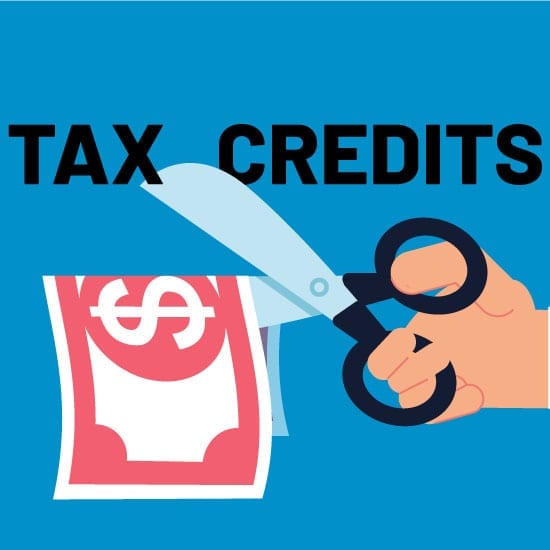7 Tax Credits to Cut My Business Tax Bill
What is a Tax Credit?
A tax credit is an amount of money that a taxpayer can subtract from the amount they owe the government in taxes. It’s different than deductions or exemptions that reduce the amount of income on which your taxes are calculated. A tax credit reduces the actual tax amount that’s due dollar-for-dollar.
Businesses are offered tax credits to induce specific behaviors, purchases, or business practices. If a company has credits that exceed its tax liability, under the right circumstances, the business can carry excess credits forward to reduce future year taxes.
Here are the basics of 7 tax credits popular with small businesses. It’s the IRS, so the devil is in the details, but you can go to IRS.gov to get details and rules.
#1: Credit for Small Employer Health Insurance Premiums
This credit can be up to 50% of the premiums you paid for health insurance coverage through a qualifying arrangement. An alternative is if you’re an eligible tax-exempt employer, you may be able to take a 35% credit of the premiums paid. You’re eligible if:
- Premiums were paid for a plan purchased through the SHOP Marketplace under a qualifying arrangement.
- You had fewer than 25 employees for the tax year.
- Though subject to annual change, the current rule is that you paid less than $54,000 in yearly wages during the tax year.
This is claimed on Form 8941.
#2: Credit for Paid Family and Medical Leave
This is a tax credit for providing paid leave to employees covered by the Family and Medical Leave Act. The Act provides up to 12 weeks of unpaid, job-protected leave, as well as access to group health benefits.
The tax credit ranges from 12.5% to 25% of the wages paid to qualifying employees on family or medical leave for up to 12 weeks, depending on the amount of the employee’s regular wages. The credit is valid for wages paid in taxable years of the employer beginning after December 31, 2017, and is not available for wages paid in taxable years beginning after December 31, 2019.
This is claimed on Form 8994.
#3: Disabled Access Credit
If you have an office or place of business that is visited by customers or clients, you are eligible for this tax credit by making your facilities fully accessible to people with disabilities. You may install ramps, upgrade restrooms, change how you present your products or services, or make other changes that help the disabled.
You must have a total revenue of $1 million or less or have 30 or fewer full-time employees. You can claim up to 50% of expenditures from $250 to $10,000, with a maximum credit of $5,000.
Claim this credit on Form 8826.
#4: Credit for Employer-Provided Childcare Facilities and Services
This credit is for businesses that directly pay childcare expenses for their employees or help them to secure childcare. The credit is 25% of the costs, plus 10% of childcare resource and referral expenses. This is a credit for up to $150,000 per year.
If you’re incorporated and an employee, you could also be eligible for the benefits.
This credit is claimed on Form 8882.
#5: Credit for Small Employer Pension Plan Startup Costs
To encourage small businesses to start pension plans, this credit is for up to $500 or 50% of your startup costs. It’s a claim you can make for the first three years of your plan. Eligibility requires:
- Fewer than 100 employees receive at least $5,000 in compensation.
- You do not have an existing 401(k) or another qualifying retirement plan for the past three years.
You can claim this credit on Form 8881.
#6: Work Opportunity Credit
This credit is for doing something you can feel great about and end up with loyal and productive employees. You get the credit for hiring employees who have traditionally faced significant barriers to employment. There are ten categories of eligible workers that include three popular groups:
- Long-term family assistance recipients.
- Unemployed veterans, including those who are disabled.
- Ex-felons
The credits are calculated on wages and could save you up to $9,000 over two years. This one is complicated and may require professional assistance.
Claim this credit on Form 5884.
#7: New Markets Credit
There are two types of organizations that help low-income communities, the CDE (Community Development Enterprises), and the CDFI (Community Development Financial Institutions. This credit is one used by real estate investors and developers with projects in the CDE and CDFI areas. Eligible projects involve acquiring, renovating, or building real estate in low-income areas such as:
- Hospitals or healthcare facilities
- Commercial or industrial buildings that create jobs
- Community centers or educational facilities
- Facilities that serve minorities or other underserved communities
The project must be located in an area that has a 20% or higher poverty rate or with median family incomes that do not exceed 80% of the larger area median income.
This credit is claimed on Form 8874.
There are other business credits available, so check on them, especially if you’re about to invest in a new way of serving customers, facility change, or hiring initiative at your company.

